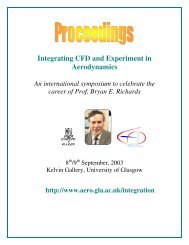Wind-tunnel interference effects on a 70° delta wing - CFD4Aircraft
Wind-tunnel interference effects on a 70° delta wing - CFD4Aircraft
Wind-tunnel interference effects on a 70° delta wing - CFD4Aircraft
Create successful ePaper yourself
Turn your PDF publications into a flip-book with our unique Google optimized e-Paper software.
ALLAN ET AL WIND-TUNNEL INTERFERENCE EFFECTS ON A <strong>70°</strong> DELTA WING NUMBERFigure 10. Flow angles at 1⋅5 <strong>wing</strong> span lengths from <strong>wing</strong>.Figure 12. Tunnel centreline pressure distributi<strong>on</strong>s.Figure 11. Comparis<strong>on</strong> of helix angles through vortex coresat x/c r = 0⋅52.Figure 13. Comparis<strong>on</strong> of circulati<strong>on</strong> distributi<strong>on</strong>s.The static pressure distributi<strong>on</strong> al<strong>on</strong>g the centreline of the <str<strong>on</strong>g>tunnel</str<strong>on</strong>g>scan be seen in Fig. 12. As the centreline passes through the <strong>wing</strong> theswitch from the pressure side to the sucti<strong>on</strong> side can be seen as ajump in the curve at approximately x/c r = 0⋅75. It is evident that asthe <str<strong>on</strong>g>tunnel</str<strong>on</strong>g> size decreases the static pressure beneath the <strong>wing</strong>increases (as expected due to increasing fr<strong>on</strong>tal area blockage). Thesucti<strong>on</strong> over the <strong>wing</strong> upper surface also increases with decreasing<str<strong>on</strong>g>tunnel</str<strong>on</strong>g> size. Figure 12 also indicates that the broken down vortexsystem is lifted into the centre of the <str<strong>on</strong>g>tunnel</str<strong>on</strong>g>s. If the vortex structureis lifted, we can expect a relative decrease in local static pressureal<strong>on</strong>g the <str<strong>on</strong>g>tunnel</str<strong>on</strong>g> centreline. Behind the <strong>wing</strong> the <str<strong>on</strong>g>tunnel</str<strong>on</strong>g> pressuredistributi<strong>on</strong>s are slightly above that of the farfield soluti<strong>on</strong>.However, it should be recalled that there are two influences <strong>on</strong> the<str<strong>on</strong>g>tunnel</str<strong>on</strong>g> static pressure in this regi<strong>on</strong>, the blockage effect increasingthe static pressure within the <str<strong>on</strong>g>tunnel</str<strong>on</strong>g> and the vortex lifting, whichdecreases the pressure in this regi<strong>on</strong>. Deducting the blockage effectwe see that there is a relative decrease in static pressure indicatingthe vortices have lifted closer to the centreline in the <str<strong>on</strong>g>tunnel</str<strong>on</strong>g> simulati<strong>on</strong>s.The displacement of the vortices was c<strong>on</strong>firmed with flowvisualisati<strong>on</strong>s.The chordwise variati<strong>on</strong> in circulati<strong>on</strong> al<strong>on</strong>g the vortices for eachcase is given in Fig. 13. The circulati<strong>on</strong> was obtained by integratingthe ω x comp<strong>on</strong>ent of the vorticity vector over ten chordwise slices.The oppositely signed sec<strong>on</strong>dary separati<strong>on</strong> regi<strong>on</strong> was omitted(which would have the effect of lowering the circulati<strong>on</strong> values).From the apex to around the midchord positi<strong>on</strong> it can be seen there isa relatively linear growth in circulati<strong>on</strong> in the chordwise directi<strong>on</strong>,after which the rate of growth in circulati<strong>on</strong> decreases (26) . Despitevortex breakdown occurring the circulati<strong>on</strong> c<strong>on</strong>tinues to increase inthe chordwise directi<strong>on</strong> (27) , eventually becoming near c<strong>on</strong>stant as thetrailing edge is reached. The integrati<strong>on</strong>s were performed over anentire extracted plane, thus it would appear rather than there being a
















